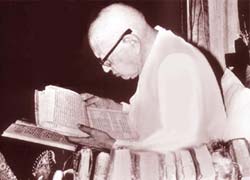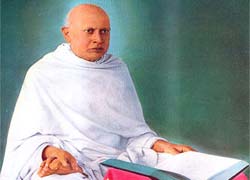In quest of Truth
 His
assertions that "vows, giving and fasting were ultimately worthless
if performed without any understanding of the soul" did not endear
him to the Sthanakvasi community. This lead to a great turmoil
in his life and in the lives of his followers. He began experiencing
distress about his own self and about his behaviour as a Sthanakvasi
monk. This came to a head at the small town of Songadh on Mahavir
Jayanti day in 1934, when he formally removed his Muhapatti (a
small white cloth to cover the mouth), left the Sthanakvasi monk-hood
and proclaimed himself to be a Digamber shravak.
His
assertions that "vows, giving and fasting were ultimately worthless
if performed without any understanding of the soul" did not endear
him to the Sthanakvasi community. This lead to a great turmoil
in his life and in the lives of his followers. He began experiencing
distress about his own self and about his behaviour as a Sthanakvasi
monk. This came to a head at the small town of Songadh on Mahavir
Jayanti day in 1934, when he formally removed his Muhapatti (a
small white cloth to cover the mouth), left the Sthanakvasi monk-hood
and proclaimed himself to be a Digamber shravak.
Even though he had some devotees, the Sthanakvasi community was understandably
enraged by this betrayal and even his life was threatened. Kanji Swami fled
to Songadh where eventually the local community became reconciled to him and
indeed virtually all of the nearly 300 families who today live at Songadh and
follow him claim to be of Sthanakvasi background. Gurudev Kanji Swami started
discourses, many of which are recorded on tapes, in the form of running commentaries
on Acharya KundKund's writings. He never wrote any books and did not claim
to say anything new but merely reiterating the words of Arihantas, acharyas
and other scholars apart from Bhagwan Mahavir Swami, KundKund Acharya and Pt.
Todarmalji.
Gurudevshri's Discourses
 Ignoring mundane topics
such as dietary prescriptions, on the basis that all Jains would
know about such matters, he directed his teachings to the subject
of the soul and to Acharya KundKund's representation of it as the
one eternal and unconditional entity. Kanji Swami's insistence
on the primacy of the absolute level of truth over the relative
one of ordinary life is obvious from his frequent comment: "Please
try to understand. No soul, with or without knowledge, has the
slightest ability to move even a particle. In such circumstances,
how can it do anything to the human body, or to any other thing
for that matter?"
Ignoring mundane topics
such as dietary prescriptions, on the basis that all Jains would
know about such matters, he directed his teachings to the subject
of the soul and to Acharya KundKund's representation of it as the
one eternal and unconditional entity. Kanji Swami's insistence
on the primacy of the absolute level of truth over the relative
one of ordinary life is obvious from his frequent comment: "Please
try to understand. No soul, with or without knowledge, has the
slightest ability to move even a particle. In such circumstances,
how can it do anything to the human body, or to any other thing
for that matter?"
For
him Samyak darshan (right faith) was a prerequisite to any meaningful
progress upon the spiritual path. "The real path lies in self-experience
of the soul after securing itself in Samyak darshan". He was
convinced that the three jewels of Samyak darshan, Samyak gyan
and Samyak charitra (right faith, right knowledge and right conduct)
could only function effectively on the basis of a prior experience
of the soul, and considered the various rituals and merit-making
practices as subordinate. In an interview in 1977 he denied being
hostile to the traditional Jain monk-hood and regarded them as
personifying the fundamental principles of Jainism. However,
he also pointed out that taking up formal initiation and behavioural
practices, like the abandonment of clothes (common for Digamber
monks) and other possessions, could not make an individual a
true monk unless he had abandoned internal possessions as well.



